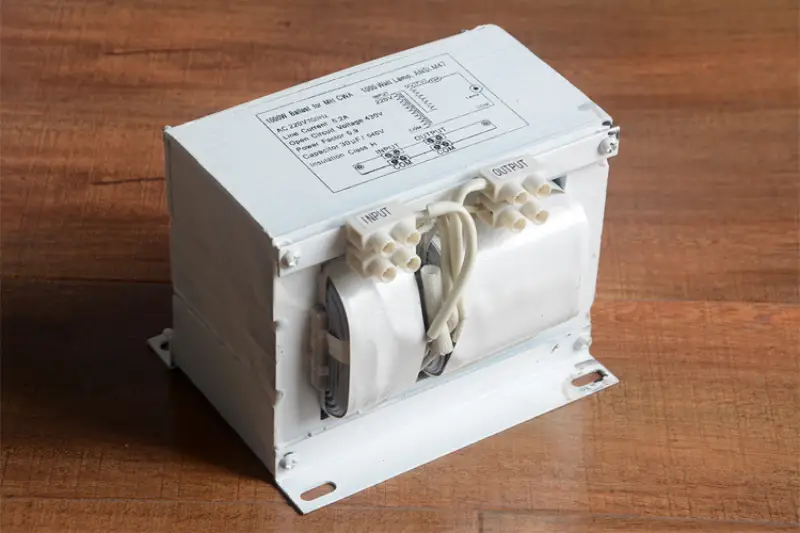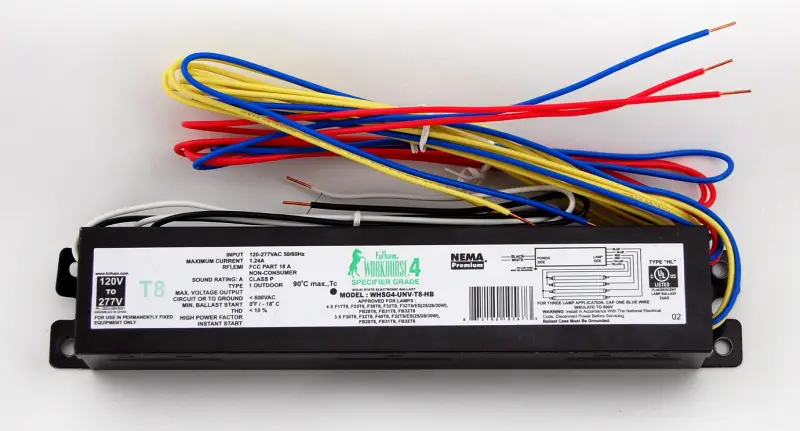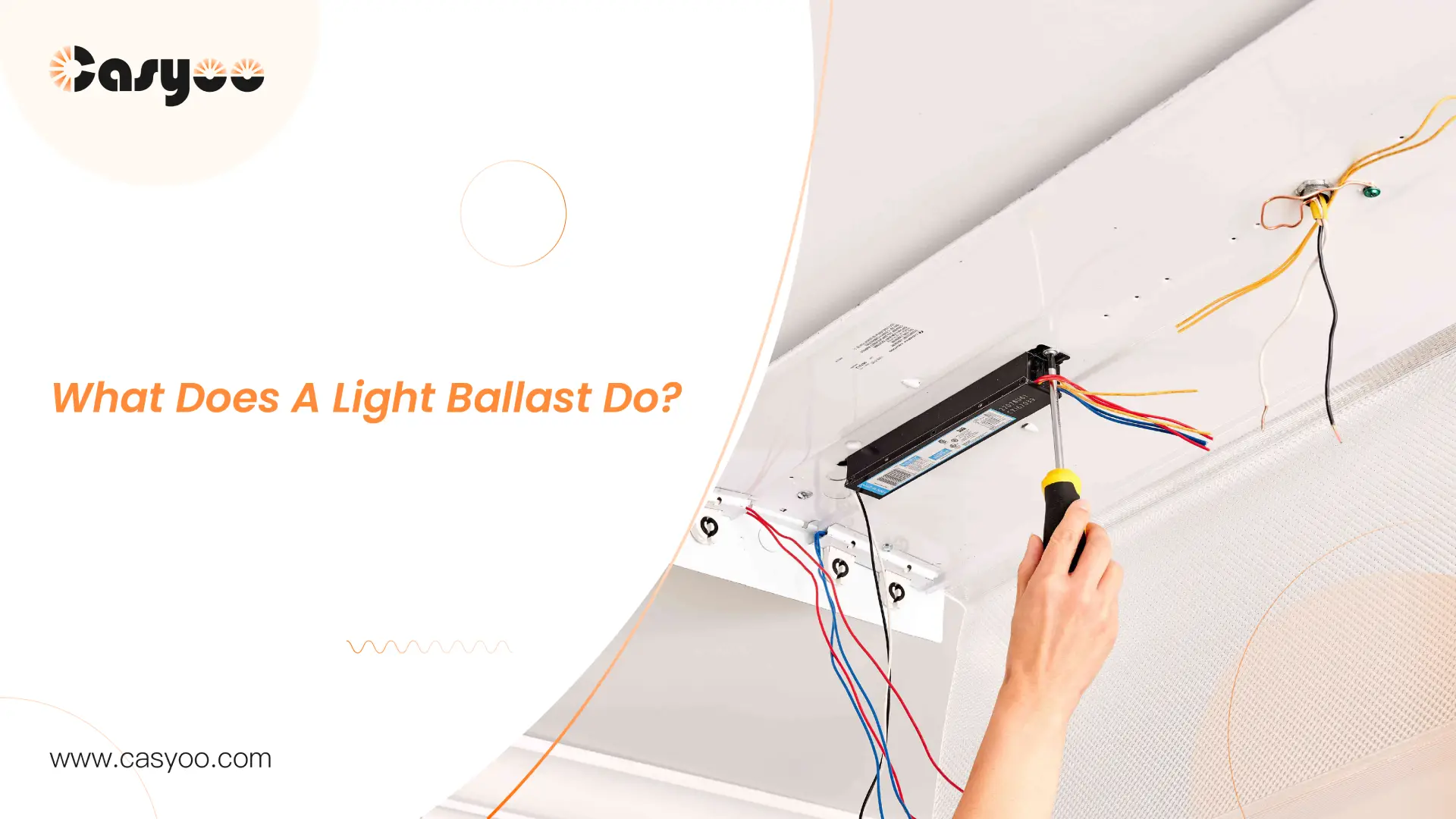The ballast is a common component of the lighting system, but is it a must-need for every type of lamp? By learning the what does a light ballast do and the features of gas discharge lamps and LED lights, you will be sure to find the answer. For those who already own lights with ballasts, you will get to know ways to check if your ballast is working and its necessity. It’s a passage that every lamp user shouldn’t miss, especially when understanding the role of a ballast in a light!!
How do inductive ballasts and electronic ballasts work?
There are two major types of ballasts: inductive ballasts and electronic ballasts.
Working principle of inductive ballasts
In an inductive ballast, enamel wire is coiled around a silicon steel iron core. When such a coil with an iron core is turned on or off instantaneously, it will produce high voltage through self-induction. The gas discharge lamp’s filament will heat up and release electrons when it is on. At the same time, the gas discharge in the starter emits a glow, causing the moving and static contacts to contact and separate. The power supply voltage and the instantaneous high voltage produced by the ballast are applied to the two ends of the lamp tube to create a powerful electric field. The ionized gas begins to conduct electricity and the lamp lights up.

Working principle of electronic ballasts
While working, the electronic ballast first converts the 50Hz frequency AC power used in the home into DC power. Next, the DC power is transformed into AC power at a high frequency (20K-100KHz). The high-frequency current generates a strong electric field between the electrodes of the lamp tube, causing the gas to discharge and the lamp tube to lights up.

What does a light ballast do?
- Generate high voltage and produce enough electromotive force for the lamp to light up.
- Save energy: The ballast can ensure that the lamp works at a frequency of 20 to 60 Hz, which increases the lamp’s efficiency by about 10%. The ballast itself consumes relatively little
- Prevent flickering: Stable light can improve visual resolution. Meanwhile, it can also help eliminate eye fatigue.
- Stabilize the voltage: The ballast can keep the lamp outputting the rated luminous flux.
- Stabilize power and current: Electronic ballasts are able to maintain stable current and power to avoid problems such as overload and short circuit.
- Prolong the lifespan of lights: When turning on or off the lamp, a large instantaneous current flows through it. The ballast provides a buffer time for the lamp, reducing the impact of the current on the lamp.
What is the lifespan of a light ballast?
There are many components in the electronic ballast, and the failure of any of them will cause the failure of the electronic ballast. Even if the components inside the electronic ballast work normally, the influence of lightning induction and high-voltage pulses will cause many electronic ballasts to fail. At present, the average life of electronic ballasts is about 3 years.
Due to its simple structure, the inductive ballast has a lifespan of over 10 years. The ballast may fail when there is a short circuit between its wiring or when the surface is broken down. The service life of the inductive ballast is better than that of the electronic ballast in harsh and hot environments.
What does the ballast do in a fluorescent light and other lights?
Ballasts are necessary for gas discharge lamps such as fluorescent lamps, metal halide lamps, high pressure sodium lamps, etc. Ballasts ensure the start-up and stable operation of these lamps, while preventing them from going out or flickering in a short period of time. In addition, since all gas discharge lamps have the property of negative resistance, the resistance of the lamp will drop rapidly after discharge, which may generate a high current and burn the bulb. ballast for fluorescent lights and other lights can limit the current to prevent the bulb from burning out.
Do you need ballast for LED lights?
An LED lamp transforms the electrical energy into visible light through its solid semiconductor chip. Therefore, it doesn’t need a high voltage to start working. Therefore, unlike traditional fluorescent lights, it does not use a ballast to drive the circuit. Instead, it is driven by a constant current power supply.
Can I remove ballast for LED?
If you replace old fluorescent lamps with LED lamps, you need to modify the circuit. The fluorescent light is wired in series with the ballast and parallel with the starter in this circuit. The connection of LED lights is simpler, as it can directly connect the neutral wire and the live wire. While modifying, first cut off the power, then short-circuit the ballast, remove the starter, remove the fluorescent light, and then connect the LED light.
How to tell if the lamp or the ballast is bad?
- If you want to know whether the ballast breaks down, you can check the appearance of the ballast and the lamp. If the outer shell of the lamp or ballast turns black, it means that the ballast goes bad.
- We can also use an electric pen to detect the ballast. The ballast is broken if there is no electricity at either the input or output ends. If there is electricity at the input end and no electricity at the output end, it means that there is a circuit break inside the ballast. If the outer shell of the ballast is charged, it means that there is a leakage problem in the ballast.
- If there is electricity at the input and output ends, the outer shell is not charged, but the lamp doesn’t come up, you can replace a trigger. If the lamp still does not light up, it indicates a potential issue with the ballast.
- We can also use a multimeter to detect the ballast. Use a multimeter with a resistance range of 200 to measure the resistance of the coil. An infinite resistance value indicates that the ballast has gone bad.
What happens when a light ballast goes bad?
If you do not use a ballast for gas discharge lamps and connect them directly to the wire, it can be dangerous. First, without the ballast, some lamps cannot light up, and it is likely to short-circuit and explode. Secondly, since there is no ballast for stable current and voltage control, the current will shorten the life of the lamp and cause a series of risks, such as fires.
How to fix a bad ballast?
- Turn off the power to avoid any electrical hazards.
- Remove the lampshade and the tube to locate the ballast.
- Inspect the ballast using the methods mentioned above to determine if it is the source of the issue. If replacement is necessary, unscrew the mounting screws securing the ballast.
- Take a photo of the original ballast wiring to use as a reference when connecting the new one. Disconnect all wires from the original terminals.
- Match the wires by color: connect the live and neutral wires to the input terminals of the new ballast, then use wires to connect the output terminals to the lamp tube.
- Existive wires need to be secured either by electrical tape or wire nuts.
- Mount the new ballast in place and reinstall the lighting fixture.
Do you need an electrician to change a ballast?
People with experience in electrical work can replace ballasts independently yet professional electricians are suggested for high-voltage street lighting systems. Professional installation of ballasts can also minimize hazards from bad wiring and electrical power spikes.
Conclusions
What does the ballast do for lights? They mainly serve to provide the high voltage required by gas discharge lamps and keep the voltage and current stable. LED lights use constant current drivers to work properly, so they don’t need ballasts. For gas discharge lamps, ballasts are necessary, and without them it can be very dangerous. If you find your lamps don’t light up and don’t know where the problem is, you can use the methods in this passage to test the ballast. Make sure the ballast works normally if you use gas discharge lamps and remove it if you use LED lights. Read more of Casyoo’s blogs for more tips!




